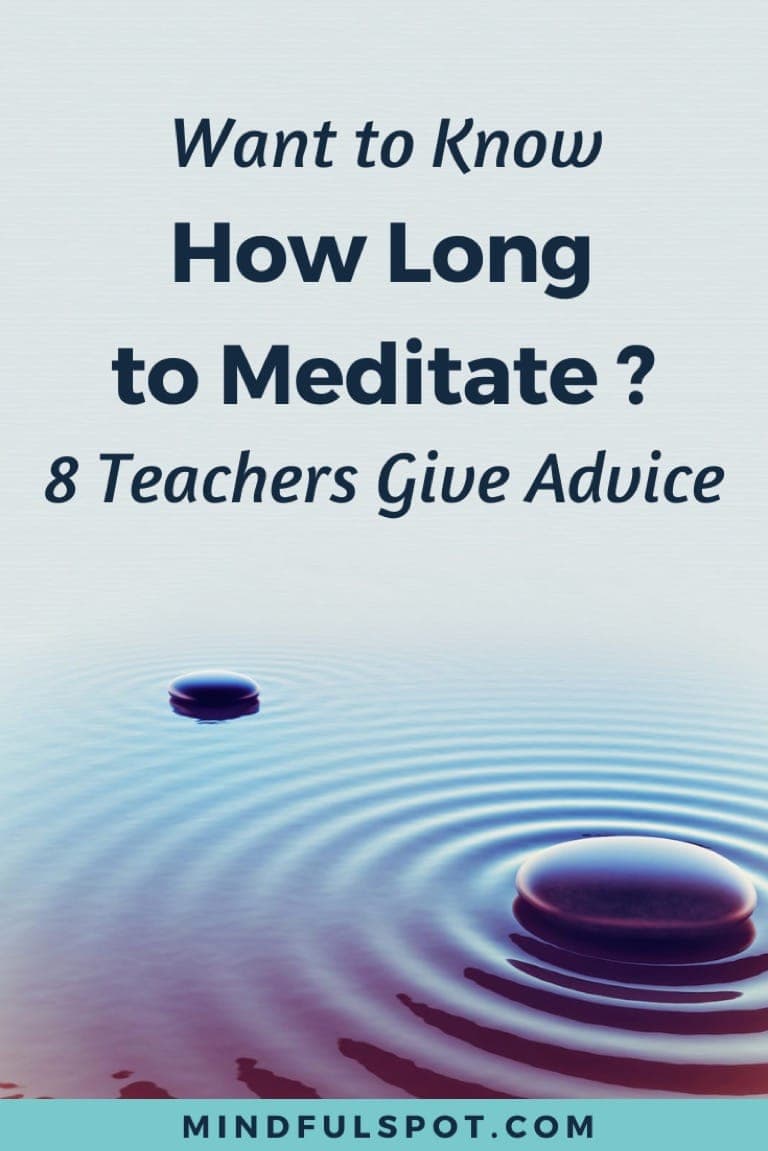How long should you meditate if you’re a beginner?
The common assumption is the longer you do it, the better. But I found the opposite is true: You get more benefit when you start small and increase duration as you become more disciplined.
Still, what is a good starting point? This article aims to clear up any misconceptions you might have around this subject and contains advice given by eight renowned meditation teachers. Here’s what they say.
How Long Should You Meditate if You’re a Beginner?
1. Answered by Thich Nhat Hanh
 Zen Master Thich Nhat Hanh is a global spiritual leader, poet, and peace activist, revered throughout the world for his powerful teachings and bestselling writings on mindfulness and peace. His key teaching is that, through mindfulness, we can learn to live happily in the present moment—the only way to truly develop peace, both in one’s self and in the world.
Zen Master Thich Nhat Hanh is a global spiritual leader, poet, and peace activist, revered throughout the world for his powerful teachings and bestselling writings on mindfulness and peace. His key teaching is that, through mindfulness, we can learn to live happily in the present moment—the only way to truly develop peace, both in one’s self and in the world.

FREE Self-Test: How Spiritual Are You?
For beginners, it is better to sit no longer than 20 or 30 minutes1. During that time, you can readily obtain total rest. The technique for obtaining this rest lies in two things — watching and letting go: watching your breath, and letting go of everything else. Release every muscle in your body. After about 15 minutes or so, it is possible to reach a deep quiet filled with inner peace and joy. Maintain this quiet and peace.
— Thich Nhat Hanh
2. Answered by Jon Kabat-Zinn
 Jon Kabat-Zinn is internationally known for his work as a scientist, writer, and meditation teacher engaged in bringing mindfulness into the mainstream of medicine and society. He is Professor of Medicine emeritus at the University of Massachusetts Medical School, where he founded its world-renowned Mindfulness-Based Stress Reduction Clinic (MBSR) in 1979, and the Center for Mindfulness in Medicine, Health Care, and Society (in 1995).
Jon Kabat-Zinn is internationally known for his work as a scientist, writer, and meditation teacher engaged in bringing mindfulness into the mainstream of medicine and society. He is Professor of Medicine emeritus at the University of Massachusetts Medical School, where he founded its world-renowned Mindfulness-Based Stress Reduction Clinic (MBSR) in 1979, and the Center for Mindfulness in Medicine, Health Care, and Society (in 1995).
There’s no real prescription, but I would say it’s good to try 15 minutes2: long enough so that you get really bored and antsy and learn how to make room for unpleasant moments. You have to have it be long enough so that you experience a lot of different body and mind states like the discomfort from being still. Then that becomes your teacher instead it being bad or an impediment to being mindful.
You notice any thoughts, like ‘I hate this,’ ‘It’s boring and stupid’ and then recognize that these are just thoughts. You may have a lot of emotions like impatience and frustration and think, ‘Well I just can’t meditate’ and perhaps you get down on yourself or decide to throw in the towel. But the whole point is just to notice the play of the mind and body, and not taking things personally when they aren’t.
— Jon Kabat-Zinn
3. Answered by Sharon Salzberg
 Sharon Salzberg had played a crucial role in bringing meditation and mindfulness practices to the West and into mainstream culture since 1974 when she first began teaching. She is the co-founder of the Insight Meditation Society in Barre, MA and the author of ten books including NY Times bestseller, Real Happiness, her seminal work, Lovingkindness, and Real Love.
Sharon Salzberg had played a crucial role in bringing meditation and mindfulness practices to the West and into mainstream culture since 1974 when she first began teaching. She is the co-founder of the Insight Meditation Society in Barre, MA and the author of ten books including NY Times bestseller, Real Happiness, her seminal work, Lovingkindness, and Real Love.
Usually, when people start sitting, we say that 5 minutes is enough3. You don’t have to think, “I’ve got to sit here for six hours.” You don’t have to get into some pretzel-like posture and suffer! Just choose an object of awareness—maybe the breath—and rest your mind there. You know that it’s not going to be 9,000 breaths before your mind wanders. It’ll likely be one. Maybe three, maybe just a half a breath!
The most important moment in the whole process is the moment after you’ve been distracted, after you’ve been lost or fallen asleep or whatever. That’s when you have the chance to be truly different. Instead of judging and berating yourself, you can practice letting go and beginning again. That’s the core teaching.
— Sharon Salzberg
4. Answered by Jack Kornfield
 Jack Kornfield trained as a Buddhist monk in the monasteries of Thailand, India, and Burma. He has taught meditation internationally since 1974 and is one of the key teachers to introduce Buddhist mindfulness practice to the West.
Jack Kornfield trained as a Buddhist monk in the monasteries of Thailand, India, and Burma. He has taught meditation internationally since 1974 and is one of the key teachers to introduce Buddhist mindfulness practice to the West.
Select a regular time for practice that suits your schedule and temperament. If you are a morning person, experiment with a sitting before breakfast. If evening fits your temperament or schedule better, try that first. Begin with sitting 10 or 20 minutes at a time4. Later you can sit longer or more frequently. Daily meditation can become like bathing or toothbrushing. It can bring a regular cleansing and calming to your heart and mind.
— Jack Kornfield
5. Answered by Joseph Goldstein
 Joseph Goldstein has been leading insight and lovingkindness meditation retreats worldwide since 1974. He is a co-founder of the Insight Meditation Society in Barre, Massachusetts, where he is one of the organization’s guiding teachers. In 1989, together with several other teachers and students of insight meditation, he helped establish the Barre Center for Buddhist Studies.
Joseph Goldstein has been leading insight and lovingkindness meditation retreats worldwide since 1974. He is a co-founder of the Insight Meditation Society in Barre, Massachusetts, where he is one of the organization’s guiding teachers. In 1989, together with several other teachers and students of insight meditation, he helped establish the Barre Center for Buddhist Studies.
To start with I think it’s good to set an amount of time that you feel workable, that inspires you to do it, that is not going to feel too daunting. So people could choose almost any amount of time. It can be 20 minutes or half an hour5. The important thing is the regularity of it. Pick an amount of time that you really feel committed to doing every day. It’s the everyday-ness that is going to build the practice.
Over time people may find that they get comfortable with that amount of time and they may feel, “What it would be like to extend it for 10 or 15 minutes?” So there is no absolute number that we need to work with. I think it’s starting with what feels doable and actually inspires one to do it and then gradually expand the time as one feels necessary. At a certain point, for people who have developed a strong practice sitting an hour a day would be great. Some people sit 2 hours a day, so there is no upper limit.
— Joseph Goldstein
6. Answered by Tara Brach
 Tara Brach has been practicing and teaching meditation since 1975, as well as leading workshops and meditation retreats at centers throughout North America and Europe. She is the founder of the Insight Meditation Community of Washington (IMCW) and the author of Radical Acceptance (2003) and True Refuge (2013).
Tara Brach has been practicing and teaching meditation since 1975, as well as leading workshops and meditation retreats at centers throughout North America and Europe. She is the founder of the Insight Meditation Community of Washington (IMCW) and the author of Radical Acceptance (2003) and True Refuge (2013).
Deciding in advance the duration of your sit can help support your practice. For many, a good time frame is between 15-45 minutes6. If you sit each day, you’ll gradually experience noticeable benefits (e.g., less reactivity, more calm) and be more inclined to increase your sitting time.
If you’re just beginning a meditation practice, you might want to experiment with the length of time that you meditate. You might choose to meditate for just five minutes once or twice a day, and increase the time by five minutes a day until you reach a length of time that you can commit to on a daily basis.
— Tara Brach
7. Answered by Eckhart Tolle
 Eckhart Tolle is a spiritual teacher and the author of the #1 New York Times bestseller The Power of Now and the highly acclaimed follow-up A New Earth, which are widely regarded as two of the most influential spiritual books of our time.
Eckhart Tolle is a spiritual teacher and the author of the #1 New York Times bestseller The Power of Now and the highly acclaimed follow-up A New Earth, which are widely regarded as two of the most influential spiritual books of our time.
It needn’t take long. 10 to 15 minutes of clock time should be sufficient7. Make sure first that there are no external distractions such as telephones or people who are likely to interrupt you. Sit on a chair, but don’t lean back. Keep the spine erect. Doing so will help you to stay alert. Alternatively, choose your own favorite position for meditation.
Make sure the body is relaxed. Close your eyes. Take a few deep breaths. Feel yourself breathing into the lower abdomen, as it were. Observe how it expands and contracts slightly with each in and out breath. Then become aware of the entire inner energy field of the body. Don’t think about it — feel it. By doing this, you reclaim consciousness from the mind.
— Eckhart Tolle
8. Answered by Andy Puddicombe
 Andy Puddicombe is the meditation and mindfulness expert, co-founder of Headspace, which teaches simple, 10-minute meditation techniques to busy professionals.
Andy Puddicombe is the meditation and mindfulness expert, co-founder of Headspace, which teaches simple, 10-minute meditation techniques to busy professionals.
If it feels like too much time, it probably is. It’s best to approach meditation much like anything else in life: start small, build up slowly and find your own personal sweet spot. For some people, this sweet spot is 10 minutes8 and for others, it’s 60 minutes.
To begin with, the most important thing is finding a time length which feels achievable and keeps us feeling motivated. Without this, it will never become part of an established daily routine. Also important to remember is that when it comes to awareness and compassion, quality always trumps quantity, so it’s much better to be actively cultivating those qualities than sitting still like a statue wondering when the session will end. (We’ve all been there!)
So what is the optimal amount? Well, science is still working that equation out. Many of the recent findings seem to be pointing at frequency rather than duration. So for example, 10 minutes a day, every day of the week, is likely to be far more beneficial than 70 minutes on one day of the week.
— Andy Puddicombe
The Takeaway
If you compare all the answers above, you’ll see that new practitioners should meditate for five or fifteen minutes.
I started with ten minutes a day: It was enough to calm my body, focus on the breathing, and work with persisting negative thoughts and emotions.

FREE mindfulness resources for stress relief
Complement with guides on relaxing meditation postures for beginners and how to practice mindful breathing.

Footnotes
- Thich Nhat Hanh. The Miracle of Mindfulness: An Introduction to the Practice of Meditation, p. 35↑
- Jon Kabat-Zinn. Q&A: Jon Kabat-Zinn Talks About Bringing Mindfulness Meditation to Medicine. Time↑
- Sharon Salzberg. You Can’t Fail at Meditation. Lion’s Roar↑
- Jack Kornfield. Establishing a Daily Meditation. Official Website↑
- Joseph Goldstein. 3 Ways to Build a Sustainable Meditation Practice. YouTube↑
- Tara Brach. FAQ for Meditation. Official Website↑
- Eckhart Tolle. The Power of Now: A Guide to Spiritual Enlightenment. New World Library. Kindle Edition, p. 129↑
- Andy Puddicombe. What’s the right amount of time to meditate? Headspace↑
I’m a freelance writer and mindfulness advocate behind this blog. I started my meditation practice in 2014, and in 2017 I launched this website to share what I learn with others. Here are the three things you can do here:
1. Schedule a free consult if you want to learn Buddhist meditation.
2. Download free mindfulness resources for stress relief
3. Join Patreon for exclusive content and community meetings.






experimenting with 7hrs sleep 1hr meditation first thing early morning. Thanks for collating all this.
Hey John, my favorite time to meditate is also early morning, usually right after morning exercise and before breakfast. I found that this helps me to concentrate better on my body and breathing but also allows me to eat my breakfast slowly and mindfully. I made it a part of my routine, so I rarely miss my morning meditation.